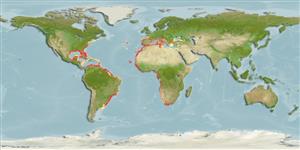Classification / Names
Common names from other countries
Main reference
Size / Weight / Age
Max length : 30.0 cm TL male/unsexed; (Ref. 188); common length : 25.0 cm SL male/unsexed; (Ref. 188); max. published weight: 229.00 g (Ref. 5217); max. reported age: 7 years (Ref. 839)
Length at first maturity
Lm 14.4, range 14 - 21.5 cm
Environment
Marine; brackish; reef-associated; oceanodromous (Ref. 51243); depth range 0 - 350 m (Ref. 5286)
Climate / Range
Subtropical; 24°C - ? (Ref. 54867), preferred 24°C (Ref. 107945); 47°N - 40°S, 98°W - 43°E (Ref. 54867)
Distribution
Atlantic Ocean: West African coast from Gibraltar southward to Saldanha Bay in South Africa (Ref. 188, 81269, 81631); also in Mediterranean Sea (Ref. 188, 81631) and Black Sea (Ref. 188). In western Atlantic Ocean from Cape Cod in USA to Argentina (Ref. 188), including Bahamas, Antilles, Gulf of Mexico and the Caribbean coast (Ref. 26938).
Countries | FAO areas | Ecosystems | Occurrences | Introductions
Short description
Dorsal
spines
(total): 0;
Dorsal
soft rays
(total): 13-21;
Anal
spines: 0;
Anal
soft rays: 12 - 23. Diagnosis: Body elongate, usually subcylindrical, but sometimes a little compressed; belly rather rounded, but scutes apparent (Ref. 188, 81269). Lower gillrakers fine and numerous, more than 80; anterior gillrakers on lower limbs of second and third gill arches lying more or less flat (Ref. 188). The pelvic finray count of 1 unbranched and 8 branched rays distinguishes Sardinella aurita from all other species of Sardinella, Harengula, Opisthonema, Herklotsichthys and Amblygaster that occur with it (Ref. 188). It resembles Clupea but it has two fleshy outgrowths along outer margin of gill opening and numerous fine fronto-parietal striae on top of head (Ref. 188). Flanks silvery, with a faint golden midlateral line, preceded by a faint golden spot behind gill opening; a distinct black spot at hind border of gill cover (Ref. 188, 3259).
IUCN Red List Status (Ref. 115185)
Threat to humans
Harmless
Human uses
Fisheries: highly commercial; bait: usually
Tools
Special reports
Download XML
Internet sources
Estimates of some properties based on models
Phylogenetic diversity index
PD50 = 0.5000 many relatives (e.g. carps) 0.5 - 2.0 few relatives (e.g. lungfishes)
Trophic Level
3.4 ±0.5 se; Based on diet studies.
Resilience
High, minimum population doubling time less than 15 months (K=0.25-1.2; tm=1; tmax=7)
Vulnerability
Low to moderate vulnerability (25 of 100)
Price category
